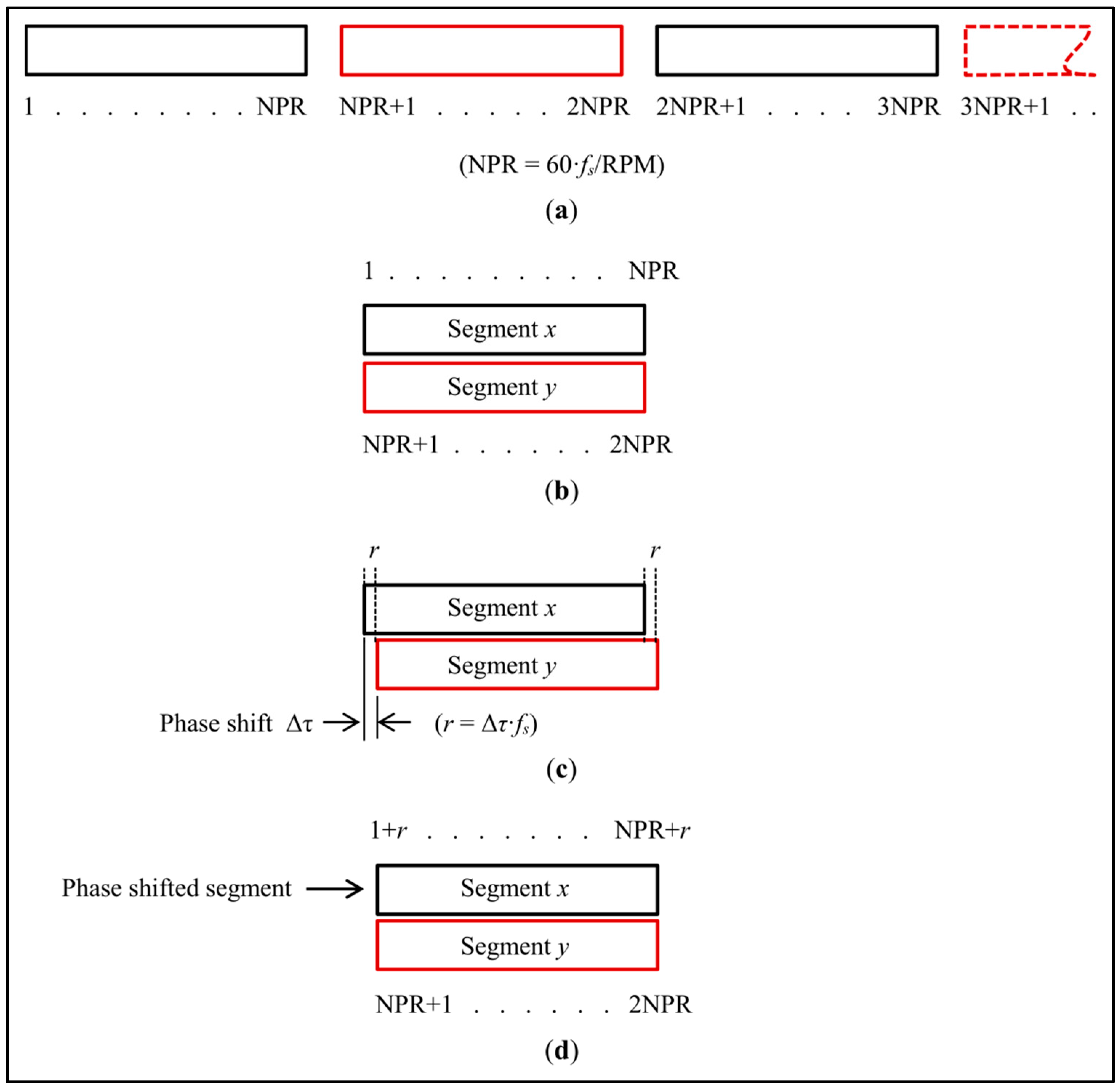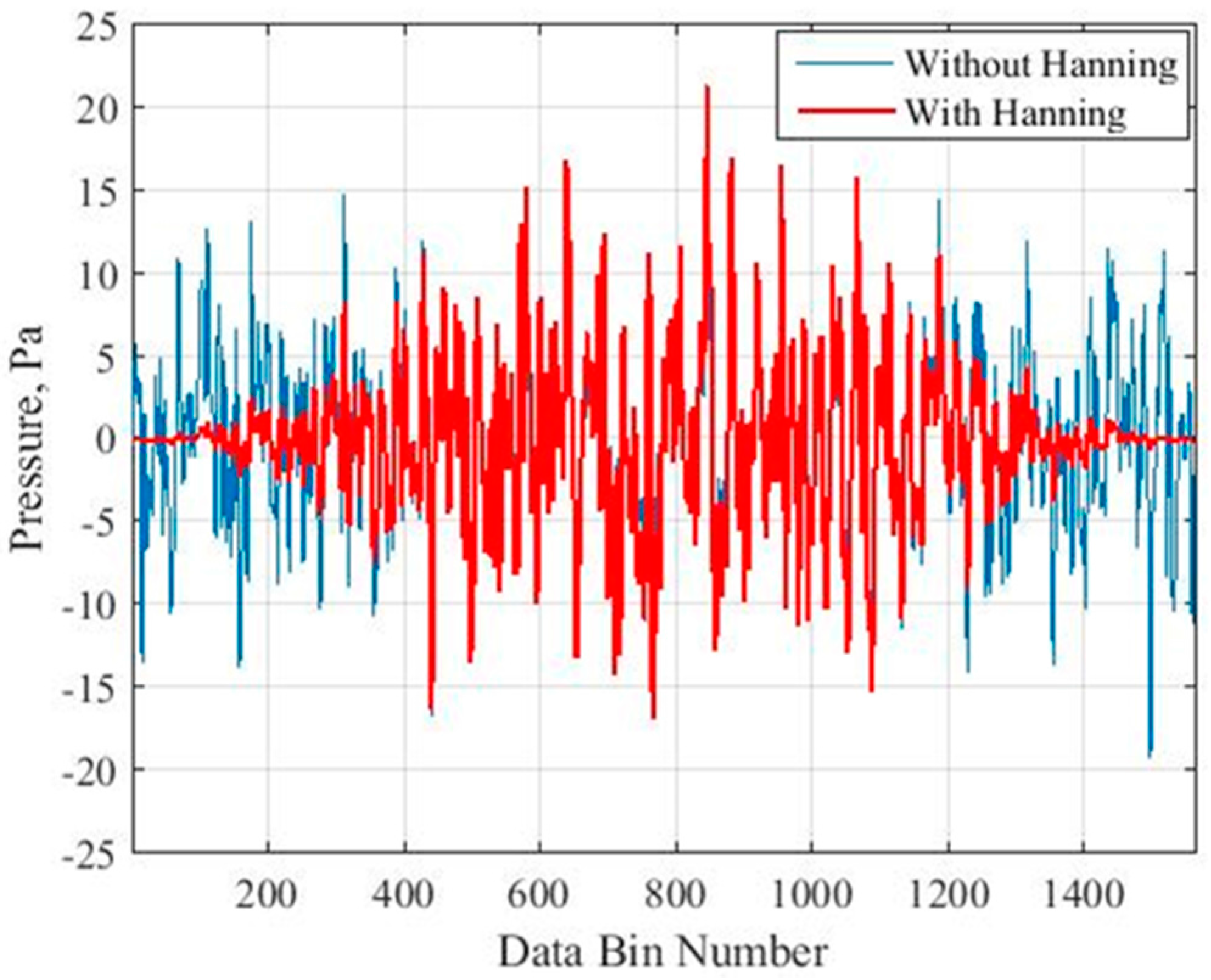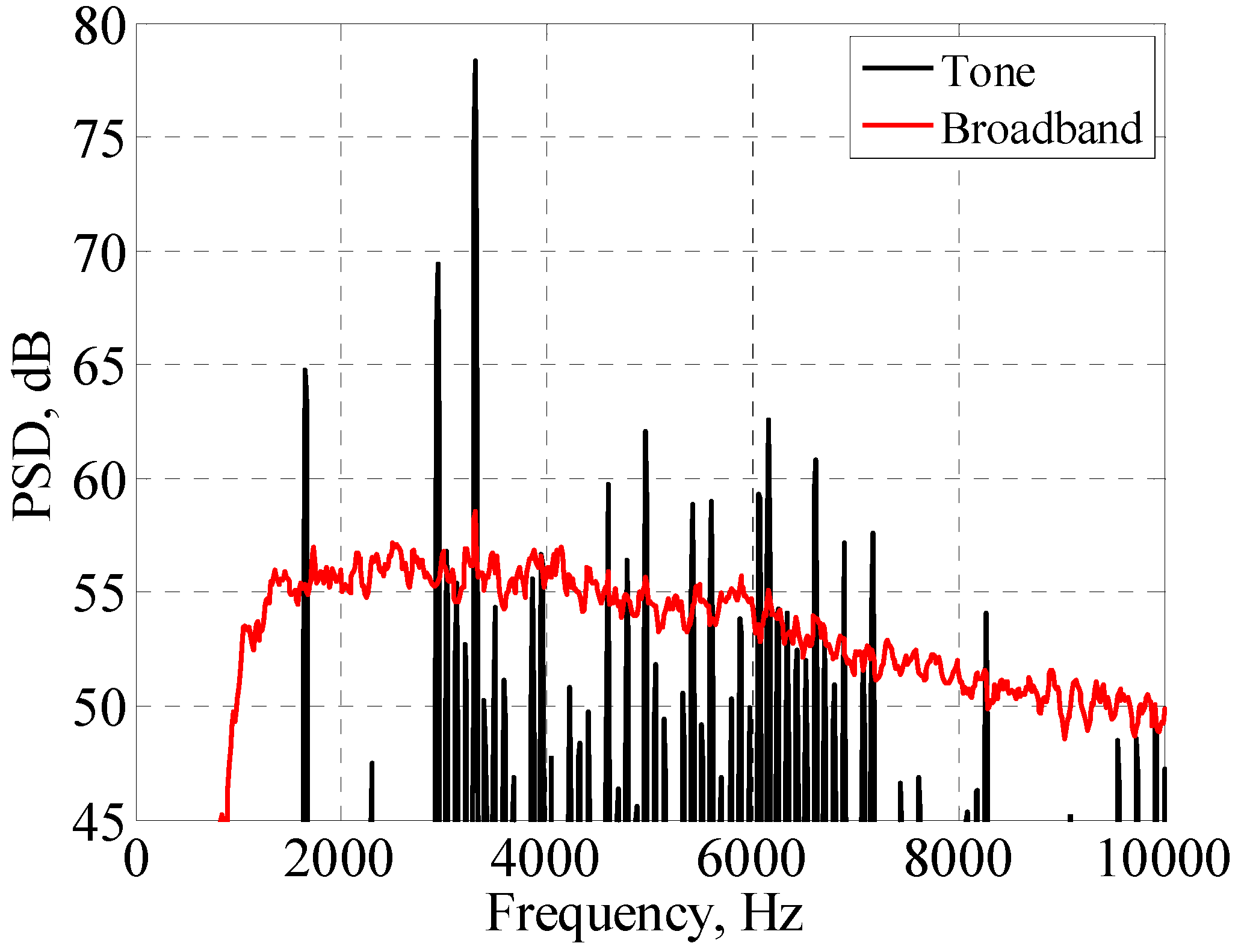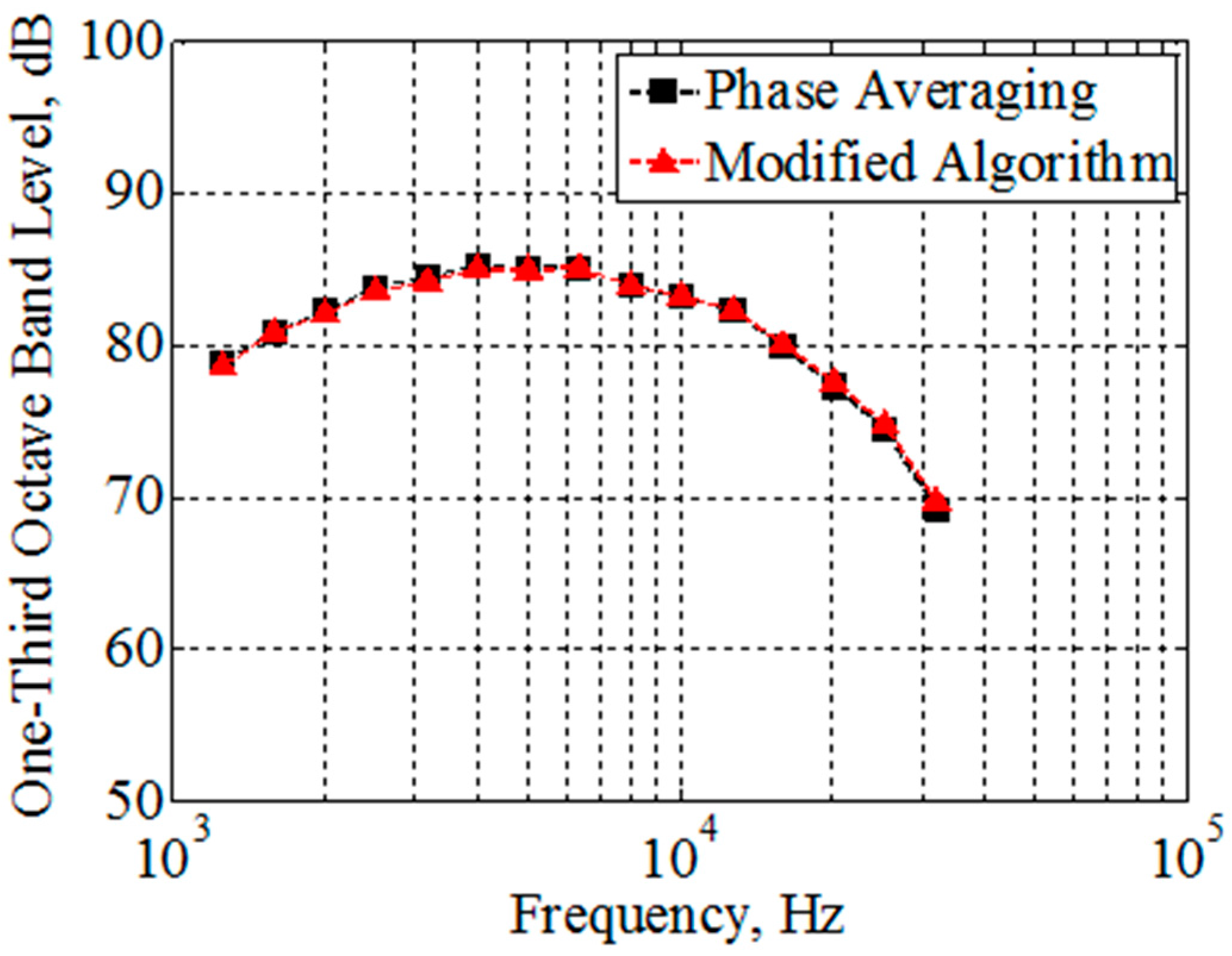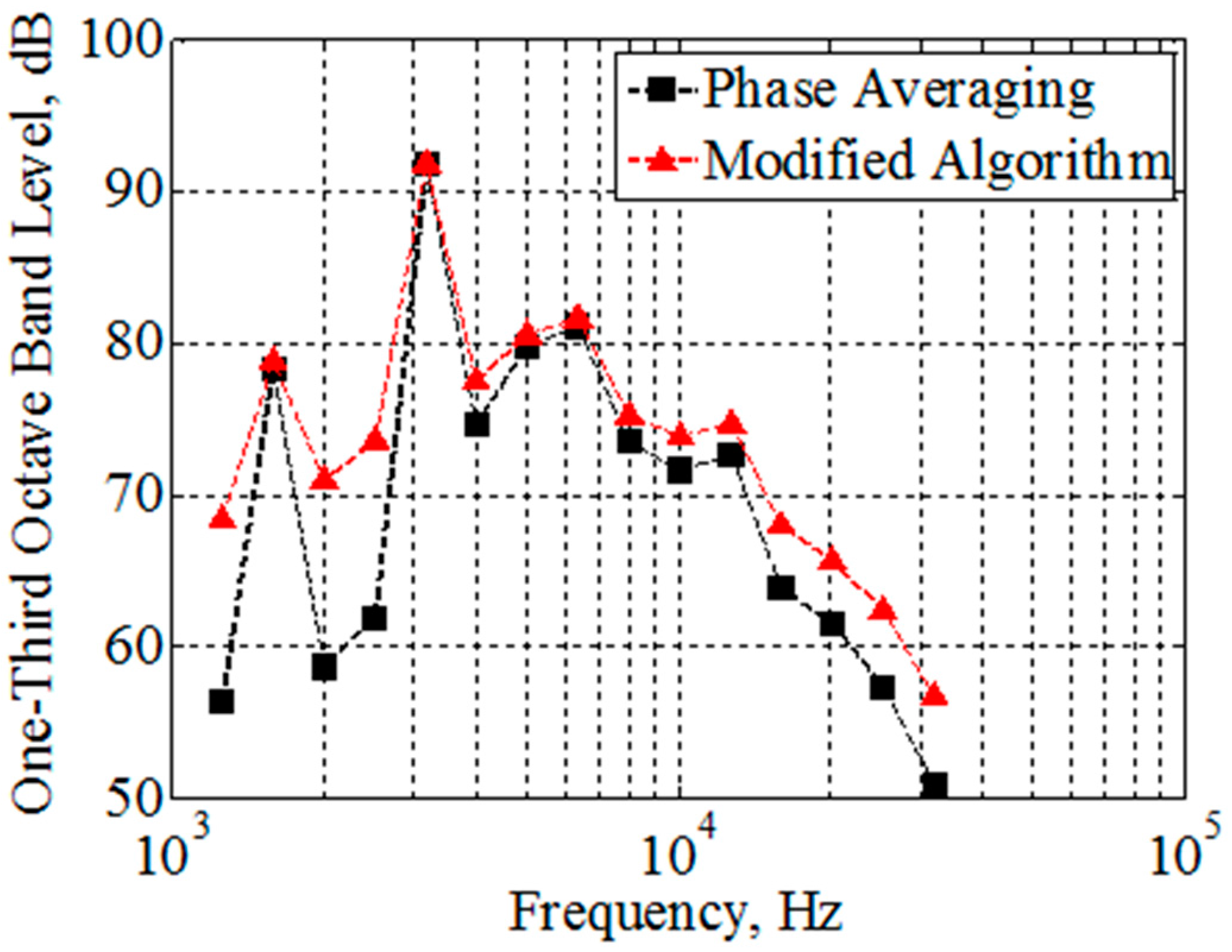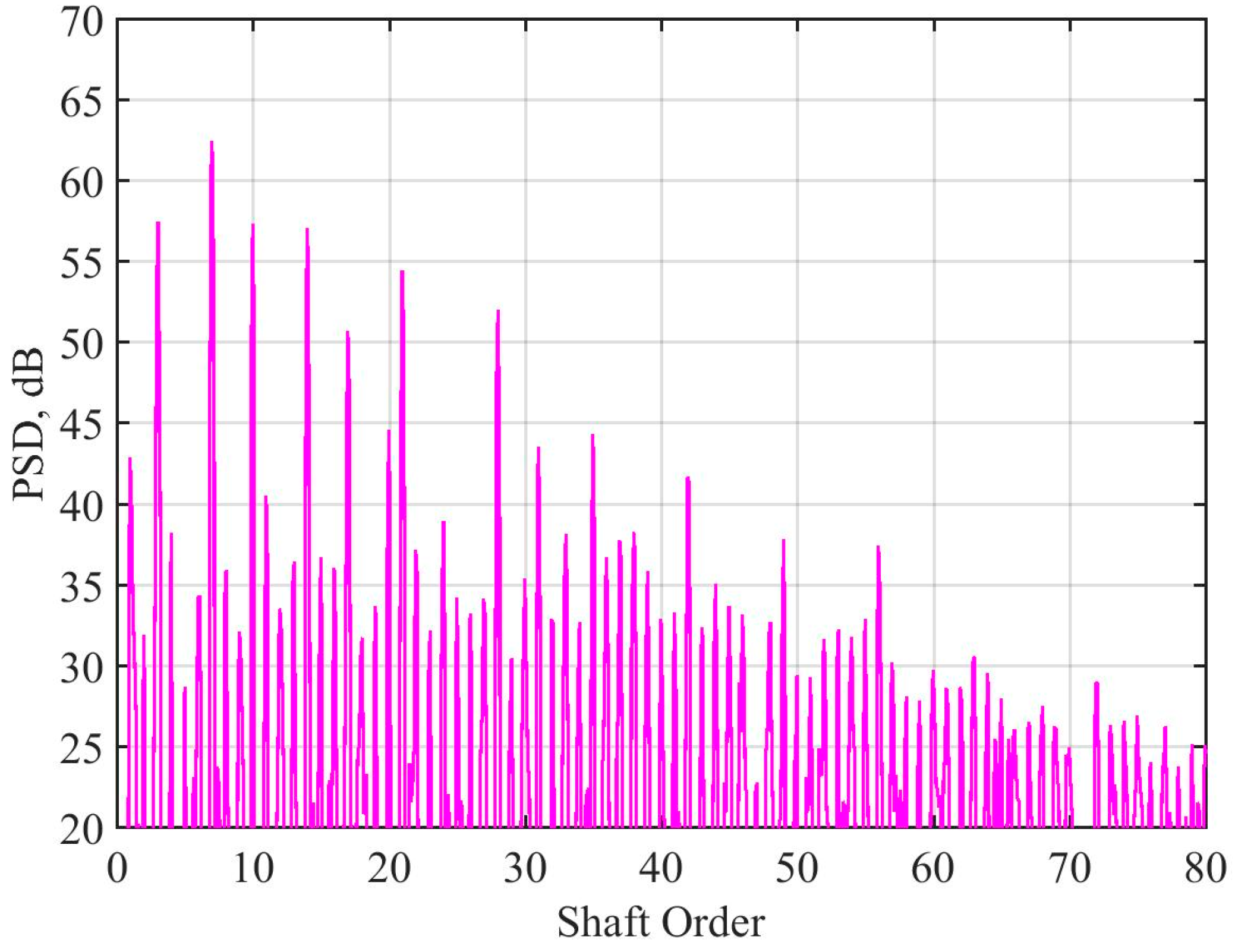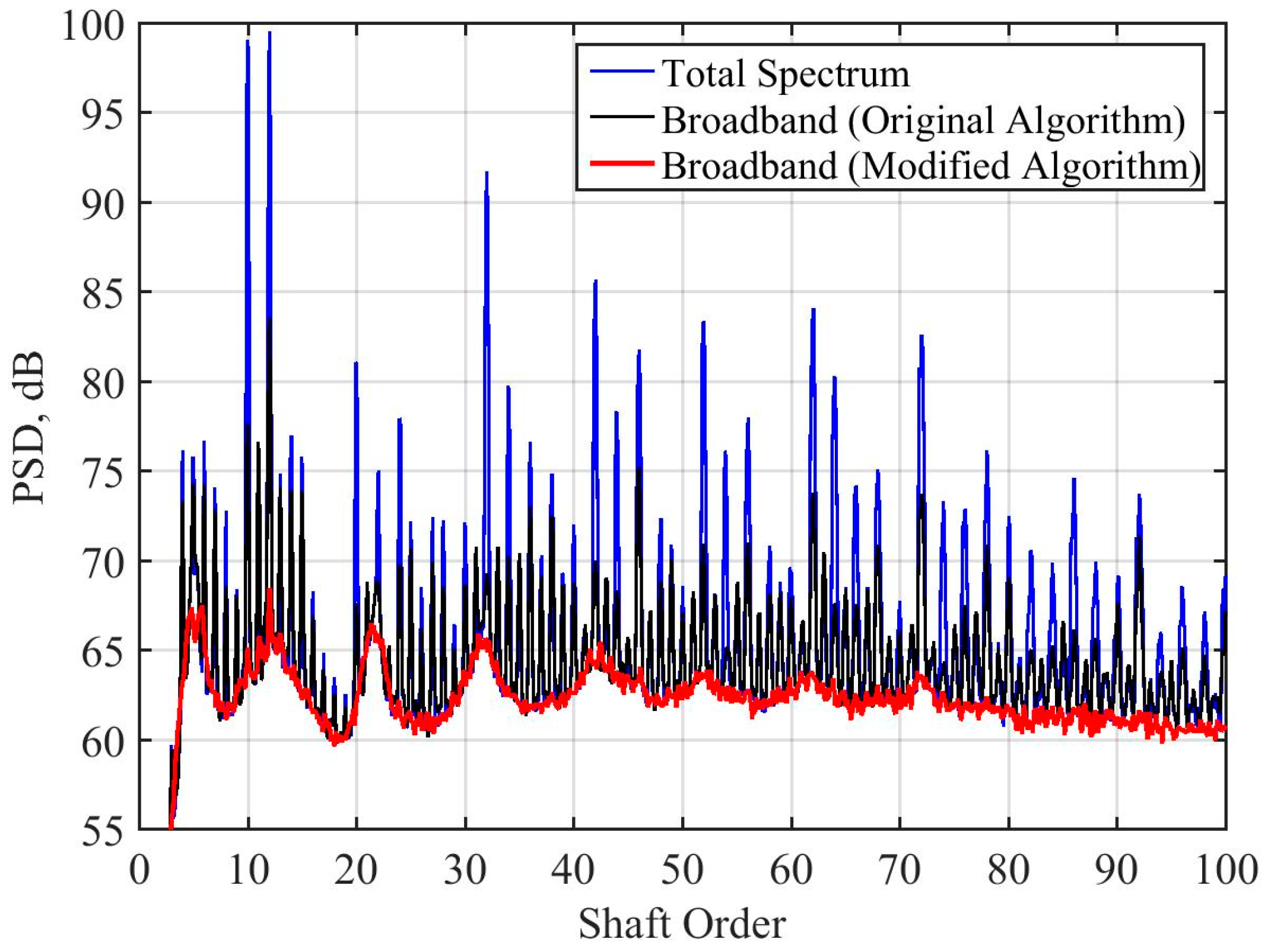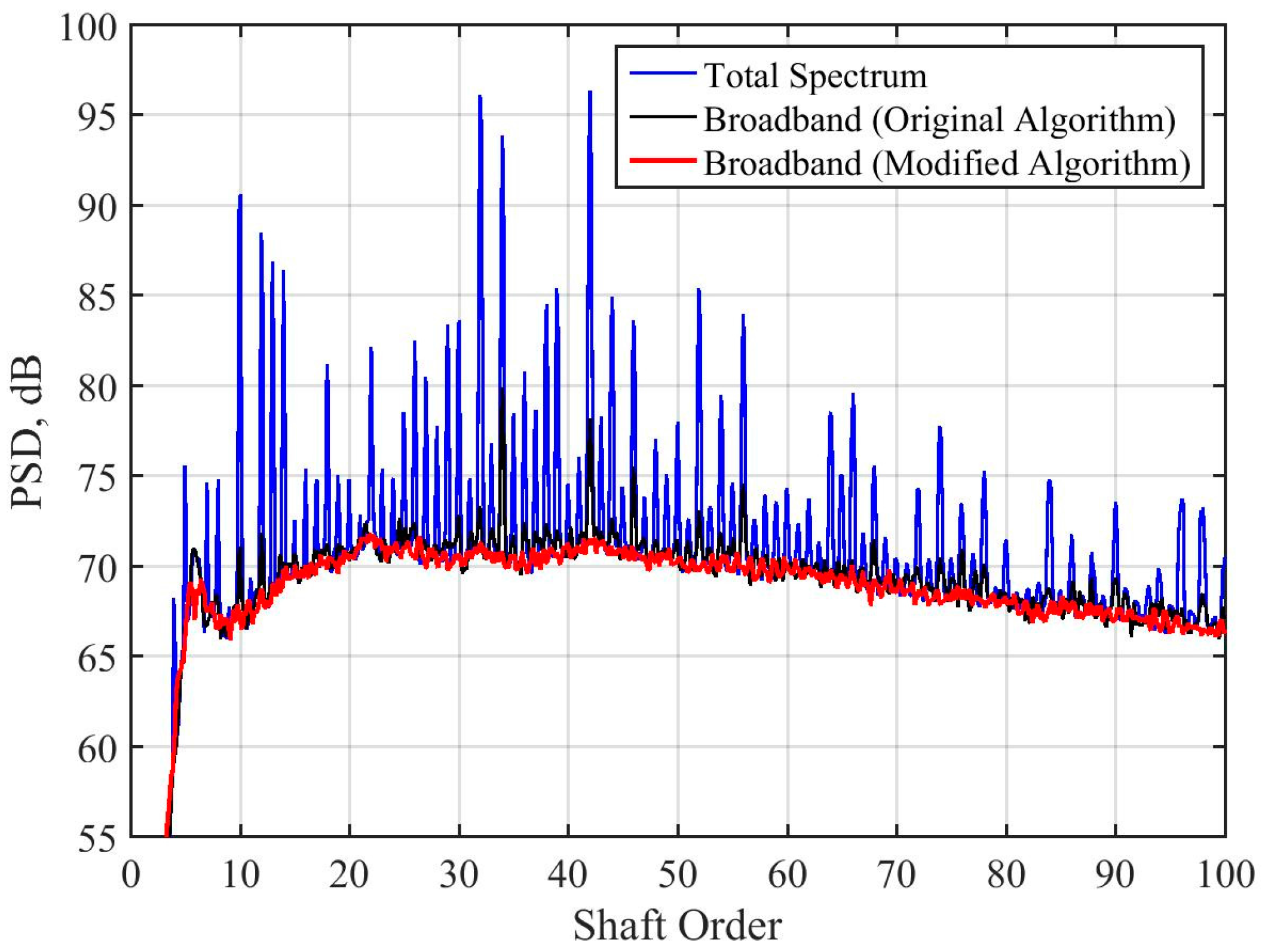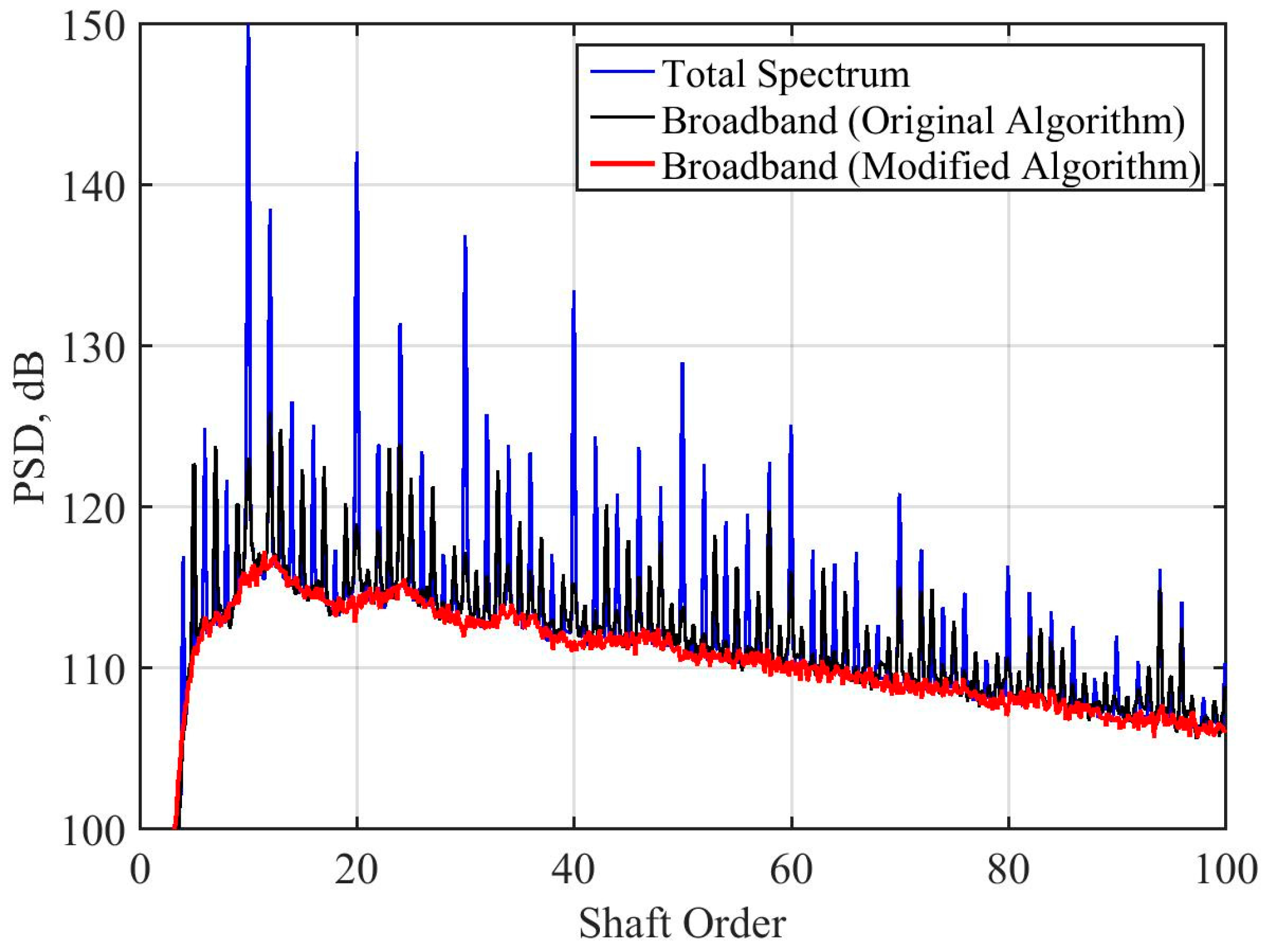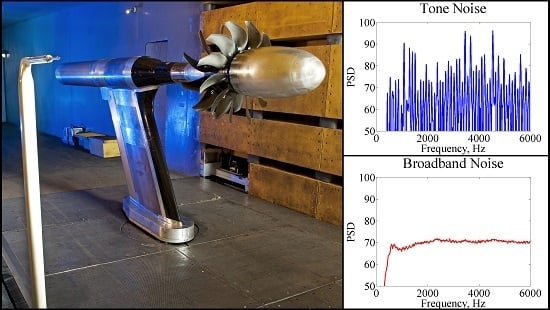1. Introduction
Renewed interest in counter-rotating open rotor technology for aircraft propulsion application (see References [
1,
2,
3,
4]) has prompted the development of advanced diagnostic tools for better design and improved acoustical performance. The term “open rotor” here refers to unducted counter-rotating dual rotors or propellers. The noise generated by an open rotor is very complex and needs special techniques for its analysis. The acoustic spectra from open rotor systems are known to be dominated by a profusion of tones, although the broadband component can also be a significant contributor to the total noise level [
5]. The knowledge of individual noise levels of tone and broadband plays an important role in many noise reduction analyses. Thus, the determination of tone and broadband noise components is very important for properly assessing the noise control parameters and also for validating open rotor noise simulation codes [
6,
7].
A signal processing technique was recently developed by Sree [
1] to separate the tone and broadband noise components from open rotor acoustic data. To demonstrate its applicability, the technique was applied to simulated data as well as realistic acoustic data generated from a Himax hobby-aircraft open rotor, referred to as “mini-open rotor”, having four forward and three aft blades [
1]. The technique was also applied recently to acoustic data generated from a 1/5th scale open rotor model, equipped with so-called “F31/A31” rotor blades in a 12-forward and 10-aft configuration, operating at realistic Mach numbers and tip speeds [
8]. In both cases the two rotors were running at about equal speeds. Although reasonable separations of tone and broadband noise components were achieved in these two cases, the technique did not provide completely satisfactory results for certain datasets. It was found to result in non-trivial tone content still remaining in the broadband spectrum. The separated broadband spectra showed sharp “spikes” (or “blips”) at tone-dominated frequencies. (see, for example,
Section 4.1. Specific cases of some of these results from the original algorithm will be included in
Section 4 of this paper.) These spikes were significantly lower in amplitude than the corresponding tone levels. This implies that the acoustic power in tone or broadband was not being quantified properly. The limitations of the original technique have already been discussed by Sree [
1], and Sree and Stephens [
8].
In the data processing technique developed by Sree [
1] the measured time series data is divided into uniform segments of a known number of samples and a cross-correlation operation is applied between two successive raw data segments to identify the phase shifts. These phase shifts in raw open rotor acoustic data are usually random and they occur due to jitter or unsteadiness in shaft rotations and other extraneous effects. The cross-correlation technique does not account for all the phase shifts that occur in a data segment-pair, it accounts only for the most dominant one (the accuracy of the phase shift determined using the cross-correlation is limited to discrete values of the sample time. The sample rate of the data should be much larger than the rate of drift of shaft phase. It seems as though this implies the method would only work on time-stationary data, but this has not been explored experimentally). After the dominant phase shift is determined, a phase-adjustment scheme is then applied to minimize the effect of the phase shift in the data segment-pair. It was demonstrated through use of simulated and realistic data (see [
1,
8]) that the presence of unresolved or unaccounted temporal phase shifts (or time lag) between the raw data segment-pairs contribute to “tone-like” spikes that appear in the broadband spectrum. A new way of processing the open rotor data had to be devised to minimize the effects of phase shifts and thereby eliminate the spike levels in the broadband spectrum. This continued search resulted in an improved method that involved a few modifications to the original technique. This improved method was found to work well for data from both single-shaft turbofan models and two-shaft counter-rotating propeller models with both shafts running at equal speed. Additionally, a separate study revealed that this new method works much better than the peak detection technique [
5,
9] in separating the tone and broadband components. Peak detection algorithms are inherently subjective, requiring either an expected spectral shape, peak height threshold, or other smoothing parameters. The user typically runs them multiple times, comparing the results against their expectations. It is not rigorous or mathematically well defined, hence not considered in this work.
The main purpose of this paper, therefore, is to present a description of the modified version of the original technique and to demonstrate its success through relevant examples. The same mini-open rotor data set used in [
1] and a subset of the F31/A31 open rotor model datasets used in [
8] will be again considered to make the comparisons and illustrate the improvements in tone and broadband separation. The emphasis will be on presenting improved results of tone and broadband separation rather than on technical details of experimentation and aeroacoustic characteristics of the open rotor models involved.
2. The Modified Algorithm
The original data processing technique by Sree [
1] was based on combining cross-correlation and fast-Fourier transform (FFT) operations and was applied to separate the tone and broadband noise components from measured raw acoustic data of model open rotor systems. This technique, as stated earlier, has been modified to further minimize or eliminate the occurrences of unaccounted random phase shifts in the data segment-pairs. The modification involves choosing a shorter data segment size for the cross-correlation operation than the one previously used and then performing a reconstruction process of the ensuing broadband time series data. The idea here is that a shorter data segment-pair will have fewer occurrences of unaccounted random phase shifts compared to a longer one as previously used. A longer data segment-pair size is presumed to contain a relatively larger number of unaccounted phase shifts compared to a shorter one, thereby leading to more “spikes” to appear in the broadband spectrum. The shortest data segment size that will be considered in this study is the one which has samples equivalent to one shaft revolution long, i.e., data segment size ≈ number of samples per revolution (NPR). NPR will be a rounded off integer number. Depending upon the frequency resolution desired, an FFT window size, NFFT, is chosen and the FFT operation is finally performed on the reconstructed broadband data. It should be noted here that, in many instances the FFT window size (NFFT), which spans over several shaft revolutions, is much longer than the data segment size (NPR) chosen for the cross-correlation operation. This modification is found to yield improved results of tone and broadband separation, particularly when the two rotor speeds are approximately equal. The main difference here is that in the original algorithm by Sree [
1] the data segment size chosen for the cross-correlation operation was of the same length as the desired window size for the FFT operation, i.e., both were of size NFFT.
The modified algorithm is similar to the original algorithm except for, as mentioned above, the selection of a shorter data segment size for the cross-correlation operation and the way the broadband signal is reconstructed. The differences between the modified and the original algorithms will be highlighted where appropriate. The steps involved in the modified algorithm are as follows:
(1) Take a uniformly-sampled raw data set obtained at a given measurement location. The raw dataset here is termed the “total” signal. Starting from the beginning, divide this signal into small uniform time-series segments each containing NPR samples equivalent to one shaft revolution long, as depicted in
Figure 1a.
The assumption here is that two consecutive rotations will be of very similar duration and have same number of samples. Note: NPR = 60·fs/RPM, where fs is the sampling frequency and RPM is the average shaft revolutions per minute. Thus, NPR depends on fs and the average shaft RPM over the measurement duration. NPR would be different in different situations, but it has to be one revolution long when the two open rotor speeds are equal. It was found from several preliminary trials that a data segment size of nominally one shaft revolution long (NPR) would give the best results. The precise number of sample points in each revolution may change, but the next step accounts for the variation in rotor phase between the rotations. Breaking down the size to less than a revolution long, say, one-half of a revolution, did not yield any further improvement in the result. This “one-revolution long” segment choice seems fitting for the data generated from rotating systems, like open rotors. Selection of NPR when multi-shaft and unequal speeds are involved is a topic of further research and will be addressed in the future.
(2) Next, starting from the beginning, take two such consecutive data segments, say
x and
y (see
Figure 1b), and perform the cross-correlation to determine the dominant phase shift, Δτ, between them (see
Figure 1c). Δτ can be positive or negative depending upon whether
x leads
y or
y leads
x. Note this phase shift Δτ is equivalent to a shift of “
r” number of samples given by
r = Δτ·
fs. This
r is typically a small number. The “
xcorr” command in MATLAB, for example, can be used to perform the cross-correlation operation.
In the present study, large amplitude and low frequency background noise from the wind tunnel was found to affect the output Δτ. The low frequency noise was below the lowest frequency of interest from the open rotor and was removed using a digital band-pass filter 500 Hz–50 kHz (which spans a shaft order range of approximately 5 to 500).
(3) Then, phase-adjust one of the segments according to the sign of Δτ and align the two segments properly as illustrated in
Figure 1d where segment
y is shown to lead segment
x by
r samples. The matching or aligning of the two segments begins with shifting segment
x to the right by
r samples. The counting of samples for the shifted segment
x now begins at 1 +
r and ends at NPR +
r, keeping the segment size at NPR always. To achieve this, the required
r samples are borrowed from the original raw dataset after the NPRth sample sequentially (notice that these borrowed samples are nothing but those from the beginning of the segment
y). This (1 +
r)th sample or the first sample of the shifted segment
x now must align with the first sample of segment
y. Then the rest of the samples of the shifted segment
x will automatically align with those of segment
y. A similar phase adjustment procedure is followed if
x leads
y. Thus, each segment after phase adjustment must have the same sample size NPR.
(4) Note each segment is composed of a common tone component plus a unique realization of a stationary random component, i.e.,
x =
+
x′ and
y =
+
y′. Being stationary in time, the two random components have the same statistics,
. This portion of the signal can be isolated by inverting one of the segments and combining them as:
x + (−
y) =
+
x′ −
−
y′ =
x′ −
y′. This cancels the tone portion of the signal, which is coherent between segment, but it amplifies the random portion of the signal, because that portion is incoherent between the segments and should be combined as mean-squared value, i.e.,:
to obtain the total broadband energy content in the data. Thus, by combining the two segments, the “broadband” signal,
z’, can be computed as:
It may be noted here that the broadband signal was determined slightly differently in the original algorithm through use of a common segment-averaged mean (
z) [
1,
8]. Either method could be used to arrive at the desired broadband spectral result.
(5) Next, starting from the end of the first segment-pair, repeat steps 2 to 4 and get the second broadband signal similar to z′. Append this signal to the one previously found in step 4 to build a pseudo time-series of the broadband signal.
Appending the individual broadband segments will create discontinuity at each junction. This discontinuity can introduce a small amount of white noise into the computed spectrum. This noise can be mitigated using a smoothing window, such as Hanning [
10], with each segment.
Figure 2 shows a typical broadband data segment with and without Hanning applied. Note the beginning and the end points of each segment (NPR long) have zero values after Hanning. These zero end points allow smooth reconstruction of the signal without any discontinuity or overlap in it. The overall loss of energy (based on variance of the signal) because of Hanning is estimated to be less than one percent.
(6) Repeat steps 2 to 5 until all the segment-pairs in the original data set are taken into account and a long time-series of the broadband signal, which has no discontinuity in it, is reconstructed. Note the total length (or sample size) of this signal will be about one-half of that of the original raw data set considered for analysis. Hence, to use this modified algorithm it is suggested that at least one million samples be collected at each measurement location.
(7) Depending upon the frequency resolution (Δ
f) desired, draw NFFT samples from the reconstructed broadband pseudo-time series data sequentially for the FFT operation. Choosing a block size of NFFT gives Δ
f =
fs/NFFT in Hz. Perform the FFT operation on each block of data to obtain the broadband spectral values as a function of frequency. A Hanning window, for example, can be used to smooth the spectral estimates. FFT gives the spectral results from zero to Nyquist frequency,
fs/2. Drawing NFFT samples sequentially and performing the FFT operation results in “NBLKS
b” of broadband spectral data, where NBLKS
b = total sample size of the reconstructed broadband data divided by NFFT (see [
10] for details on FFT operation and also cross-correlation). Note that the phase adjusting procedure (steps 2 and 3) was done to remove tones from the signal and, therefore, the reconstructed broadband signal should not have any tonal content. Thus, the NFFT block size and starting point can be arbitrary.
(8) Similarly, draw NFFT samples sequentially from the uniformly-sampled original raw acoustic data (note, this data has no discontinuity in it) and perform the FFT operation using a smoothing window on each block to obtain the “total” spectral values from zero to Nyquist frequency fs/2 with the same Δf resolution. This results in “NBLKSt” of “total” spectral data, where NBLKSt = total sample size of original raw acoustic data divided by NFFT.
Note, steps 7 and 8 describe a method for calculating an estimated power spectrum. A packaged software tool such as MATLAB can be used to perform the FFT operation. The “pwelch” command in MATLAB, for example, performs this operation.
(9) Perform a frequency-wise averaging over “NBLKSb” to obtain the final “broadband” spectral results and over “NBLKSt” to get the final “total” spectral results, in the frequency range zero to fs/2.
(10) Finally, subtract the “broadband” spectrum obtained in step 10 from the averaged “total” spectrum in step 8 to get the desired “tonal” spectrum.
It should be pointed out that the modified algorithm includes averaging in both the time and frequency domains. It is believed that this is a relatively unusual approach. Combining the two techniques (phase-adjusted temporal averaging and frequency domain spectral averaging) is one reason why this method is successful. This method was found to work well for many different input sets of data from both single-shaft turbofan models and the two-shaft counter-rotating propeller models.
3. Validation of the Modified Algorithm against Phase-Averaging
The most well-defined description of the tone portion of a signal from a rotating machine is that which is periodic with the shaft rotation. Phase-averaging is known to work well for single-shaft systems, but is ill-defined and, hence, does not work well for processing noise from multi-shaft systems, as discussed in [
1,
8]. In phase-averaging, the shaft phase is calculated by using a once-per-revolution trigger, which is sampled simultaneously with the microphone signal. This gives the shaft phase angle for each sample in the microphone time series. The microphone time series is then interpolated onto a new shaft phase vector with equal spacing in shaft phase. Then the average microphone pressure value at each shaft phase can be calculated, giving a periodic function that is called the “phase average”. This function contains all the energy in the signal that is coherent with shaft phase. This function can be repeated as many times as needed to make a time series of length equal to that of the original signal, which can then be subtracted from the original signal to give a time series of broadband energy. The noise levels, in terms of power spectral density (PSD, in decibels (dB), referenced to 20 micro-Pascals) as a function of frequency (in Hz), can be calculated from both of these signals, giving the result shown in
Figure 3 for a single-shaft model turbofan. The results from the modified algorithm using the same data are shown in
Figure 4.
The broadband spectra in these two figures seem to agree pretty well. However, residual tone components extracted from the modified algorithm are higher in number and appear noisy, but are lower in amplitude. The residual tones found in
Figure 4 occur at multiples of the shaft rate, but evidently do not repeat perfectly with each fan rotation and so are excluded from the phase average result.
A comparison of one-third octave band levels of the broadband spectra from the two methods for the same fan data are also shown in
Figure 5, and that of tone spectra in
Figure 6. These were computed by integrating the narrow-band spectra of
Figure 3 and
Figure 4 across each one-third octave band. It is noticed that the two broadband spectra in
Figure 5 seem to agree very well (within 0.6 dB) across the frequency range.
Figure 6 shows that the one-third octave bands containing tones that are as much as 5 dB below the broadband also agree well. In the one-third octave bands that do not contain tones or when the tone level is more than 5 dB below the broadband (2000 Hz for example) the extra tone components extracted by the modified algorithm lead to levels that are higher than those from the phase-averaging method.
Quantitatively these results can be compared by integrating each curve in
Figure 3 and
Figure 4 over frequency to get the overall tone and broadband sound power levels found using each method. These results were calculated and are shown in
Table 1. The results indicate a good agreement between the two methods, with only about 0.1 and 0.39 dB difference for the broadband and tone portions, respectively. The broadband spectra se two figures seem to agree rather well.
